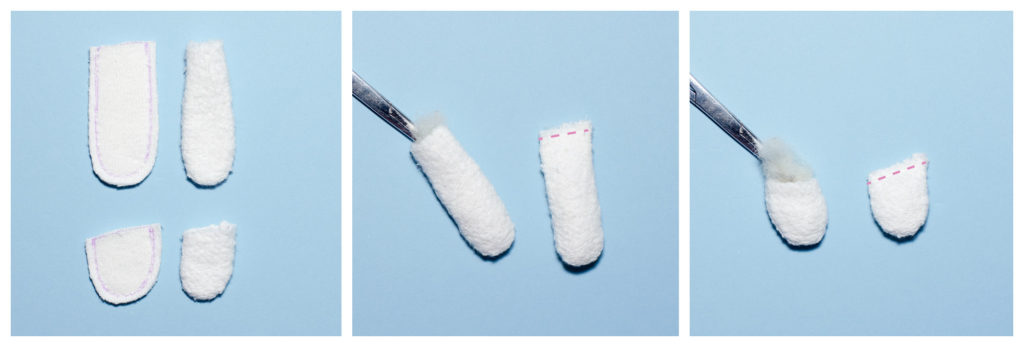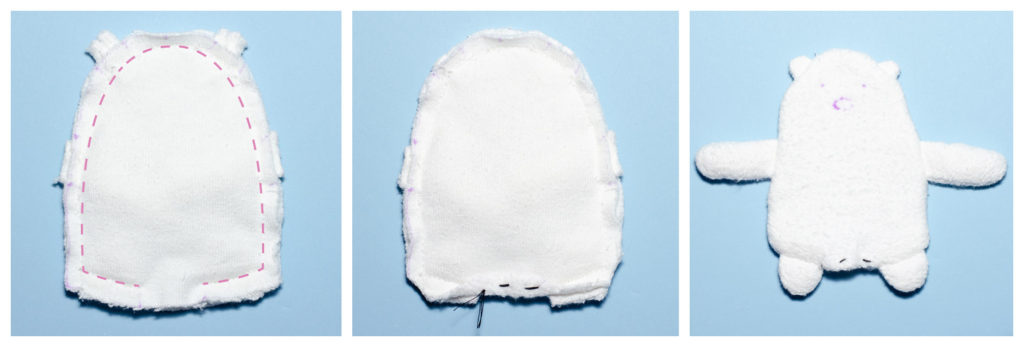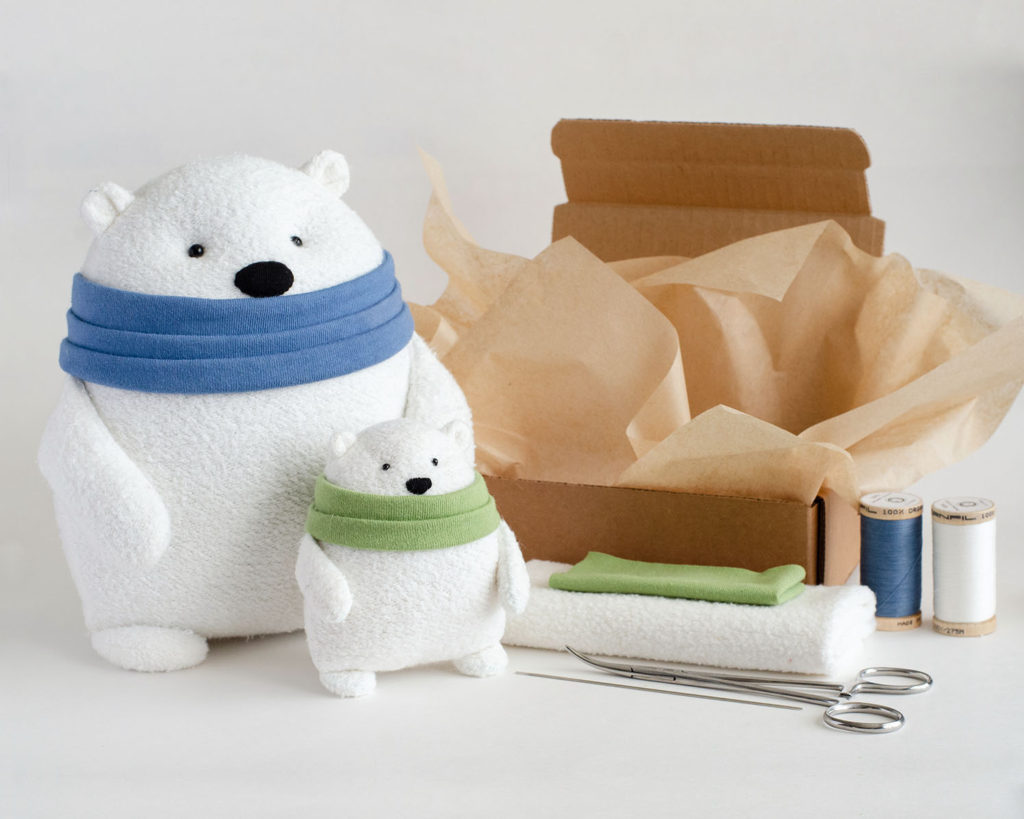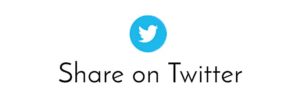
Mr. Foofs the Polar Bear Free Sewing Pattern and Tutorial
On November 5, 2018 by fluffmongerIt’s Polar Bear Week and also time to start thinking about holiday crafting! If you’re looking for the perfect DIY gift for kids, that special someone, or even yourself, look no further! Mr. Foofs the Polar Bear free sewing pattern comes in two sizes and can be sewn by hand or on the machine. Mr. Foofs can be made wearing a scarf or holding a heart, and I’ve included instructions for sewing or crocheting the scarf. Both polar bear sizes are made using the same steps with a few minor exceptions, which are explained below in the tutorial.
Materials
To make a full-size polar bear you’ll need:
-
- White fleece (I’m using sun-bleached and hand-dyed organic cotton and hemp fleece for which I have kits here) — you’ll need approximately 1/3 yard (see cutting layout below)
- A scrap piece of red fleece (if making a heart) or ¼ yard fleece or jersey knit fabric (if making cowl scarf)
- Black embroidery floss OR Black felt for nose and eyes
- Stuffing (I’m using organic carded wool from a local farm, but I also like this organic roving*. You can also use fiber stuffing, like this one made from recycled plastic bottles*)
- Matching all-purpose thread (I carry organic thread in my Etsy shop)
- Marking tool (like this disappearing pen* or this water soluble pen*)
- Scissors
- Pins or clips*
- Tool for turning and stuffing (like these hemostat clamps*)
- Doll Needle
Links with an asterisk (*) are affiliate links. If you make a purchase through one of them, I get a small percentage of the sale with no extra cost to you.
If you sew your polar bear with natural fleece, I recommend using a 90/14 ball point needle; and if you sew with organic cotton thread, I recommend making your final stitch a stretch stitch (a stretch stitch is fairly permanent, so baste first when needed).
Printing the Patterns
Get access to the free pattern, as well as access to all my other free patterns, by clicking the button below.
Print pattern at 100%. (See a tutorial on printing and assembling patterns here.)
Tracing the Pattern
- Cut out pattern. I find it easiest to trace the stitch line for small pieces and sew on folded/layered fabric, so I’m using the arm, leg, ear, and tail pattern pieces with only the seam allowance at the very end (see first photo under ‘sewing the ears, arms, and legs’).
- Line up arrows with grainline/nap direction of fabric. Trace ONLY the body pieces and transfer all markings. Detailed instructions for tracing the ears, arms, legs, tail, and heart will be provided in the steps below.
Cutting Layout

Sewing the Ears, Arms, and Legs
- Cut ear, arm, leg, and tail pattern pieces so only the seam allowance at the very end remains.
- Trace stitch line of ears on folded/layered fabric.
- Stitch around ears, tail, legs, and arms. Cut out with 1/8″ seam allowance. Turn ears right side out and run hemostat clamps/turning tool around the seams.
- Press if needed. Baste stitch ears 1/8″ from bottom edge.
- Fold outer edges of ears in toward the center at indicated markings. Baste stitch again to hold ears in folded position (you may need to baste by hand if making a tiny polar bear).

- Cut out arms and legs with 1/8″ seam allowance and turn right side out.
- Run hemostat clamps around the inside seams to help them fully open. Stuff arms and legs about 2/3 full.
- Baste leg and arm openings closed 1/8″ from edge.
Assembling the Body

- At this point, you can make the eyes and nose, or you can wait until after stuffing (I like to wait until then end so I can needle sculpt the eyes). There are a few options for the eyes and nose below:
- If making a full-size bear, you can make the eyes and nose with felt and machine or hand-stitch them 1/8″ from edge. If using the sewing machine to stitch in place, you will need to stitch them on before going any farther with the tutorial.
- If making a full-size or tiny polar bear, you can use a satin stitch for the nose and make embroidered knot eyes with embroidery floss or yarn (here’s a video tutorial on embroidering eyes with a French or colonial knot). This can be done before or after stuffing depending on your preference.
- If making a full-size polar bear, you can use glass eyes if your polar bear is not intended for a small child. (I have a tutorial here for using glass beads for eyes.)
- If making a full-size polar bear, you can use a plastic safety nose and eyes. Note that safety eyes/noses are not intended for small children, and I do not recommend using them with natural-fiber fabrics, like organic fleece. (Safety eyes typically require a small amount of fusible stabilizer or Fray Check to prevent holes in stretch fabrics.) Inserting safety eyes/noses can be done at this point or right before turning the polar bear right-side-out.
- With RIGHT sides together, stitch polar bear front to polar bear back, making a U-shape with openings for ears and arms.
- Insert the ears and arms. Make sure the insides of the ears are touching the body side with the face (see ‘inside view’). Since the ears are tiny, I recommend baste stitching them in place and turning the polar bear right side out to check their position before making your final stitching.
- Insert the legs in position shown in “inside view.”

- Stitch legs into place, leaving an opening for turning.
- Baste the seam allowance around the opening. Clip curves and corners.
- Turn polar bear right side out (if you haven’t made your eyes or nose yet, make sure you have their positions marked on the right side of the fabric before stuffing).

- Stuff the body firmly. Be sure to stuff the corners above the legs well, and continue stuffing as you close with a ladder stitch (you’ll want to use white thread, but I used colored thread so it would be visible). Here’s a video tutorial on how to ladder stitch. Remove basting stitches after closing the opening.
- If you haven’t already, make the eyes and nose. If you’d like to needle sculpt your eyes, here’s a video tutorial. And here is a tutorial for using glass beads for eyes.
The Tail

- Stitch around tail, leaving an opening for turning, and cut out.
- Flip tail right side out. Stuff gently and close the opening with a ladder stitch.
- Ladder stitch tail to indicated area on back. Secure a knot and bury the thread tails. (Here’s a video on attaching parts with a ladder stitch.)
Finish your bear with a cute scarf or heart. See directions for both below.
Making a Cowl Scarf
If you’d prefer to crochet a scarf, I’ve provided crochet instructions for both a tiny and full-size scarf at the bottom of this section.
Sewn Cowl Scarf

- For a full-size bear, cut an 8.5-in by X*-in piece of fleece or jersey knit fabric with the longest dimension along the cross grain (so the cowl can stretch when going around the neck).
- For a tiny size bear, cut a 3.5-in by X*-in piece of fleece or jersey knit fabric with the longest dimension along the cross grain (so the cowl can stretch when going around the neck).
*Measure the circumference around bear right under its nose. You’ll want your scarf to fit snugly under this area. Add half an inch (if using ¼-in seam allowance) to the amount you measured. We’ll call this final dimension ‘X.’ (My full-size bear measured 15.5-in around, so I added 1/2-in to get 16-in. So, for my bear, X=16-in.My tiny polar bear measured 7.5-in around, so I added 1/2-in to get 8-in. So, for my tiny bear, X=8-in.)
- Fold fabric lengthwise with RIGHT sides together.
- Using a stretch stitch or narrow zig-zag stitch, stitch along length of scarf with 1/4-in seam allowance.
- Reach hand through the inside of tube, grab ends of opening and pull through until the seam allowance of both openings match up.

- Pin edges, and stitch around open ends with ¼-in seam allowance, leaving a 2-in opening for turning (for full size scarf) or 3/4-in opening (for tiny scarf). This step can be stitched by hand using a backstitch if needed.
- Flip right side out, fold raw edges of opening in with ¼-in seam allowance, and close with a ladder stitch.
- Slip over polar bear’s head and the top of arms to hold them down. Scrunch scarf a bit.
Crocheted Cowl Scarf (Full Size)
- Using worsted weight yarn and a G hook, chain 24.
- Row 1: Starting in the third chain from the hook, double crochet in next 22 stitches, chain 2, and turn work.
- For the following rows (you may need more or less depending on the stretch of your fabric and how much you stuffed your bear), double crochet BLO (back loop only) in next 22 stitches, chain 2, and turn work. When you get to your final row, either slip stitch the two ends of the scarf together or fasten off and sew ends together.
- Slip over polar bear’s head and the top of arms to hold them down.
Crocheted Cowl Scarf (Tiny Size)
- Using worsted weight yarn and an E hook, chain 7.
- Row 1: Starting in second chain from the hook, single crochet BLO (back loop only) in next 6 stitches, chain 1, and turn work.
- For the following rows (you may need more or less depending on the stretch of your fabric and how much you stuffed your bear), single crochet BLO in next 6 stitches, chain 1, and turn work. When you get to your final row, fasten off.
- Slip stitch or sew ends together. Weave in ends.
- Slip over polar bear’s head and the top of arms to hold them down.

Making a Heart

- Trace heart on folded/layered fabric and stitch around heart, leaving indicated opening for turning.
- Flip right side out, stuff, and close with a ladder stitch.
- Attach heart to polar bear’s paws using a ladder stitch.
Organic Fabric Kits

If you’d like to try sewing a polar bear with organic fabric, I have fabric kits available with just the right amount of hand-dyed organic fabric to complete the project. I also have Pick 2 Kits for sewing both a full-size and a tiny polar bear.
Show Me Your Polar Bear!
I’d love to see what you make with this pattern! Post your photos in my Fluffmonger Patterns group on Facebook or share them with Fluffmonger on social media using #fluffmongerpatterns!
Selling Items Made with this Pattern or Creating Derivative Works
This pattern may be used to create handmade toys to sell, but items may not be mass-produced. Please give credit to Fluffmonger with “pattern by Fluffmonger” and a link to my website, www.fluffmonger.com on your tags and listings.
If you modify the pattern or use certain pieces to create another pattern, still credit Fluffmonger, as these are considered derivative works.
This design is protected by federal copyright law (© 2018) and may not be reproduced in any form. Reproduction of this design, either in part or whole, or distribution of this pattern electronically or by hard copy is strictly prohibited.
49 comments
Leave a Reply Cancel reply
Archives
- March 2021
- February 2021
- April 2020
- January 2020
- November 2018
- July 2018
- April 2018
- March 2018
- February 2018
- January 2018
- December 2017
- November 2017
- October 2017
- March 2017
- February 2017
- November 2016
- October 2016
- September 2016
- August 2016
- July 2016
- June 2016
- March 2016
- February 2016
- January 2016
- December 2015
- November 2015





So darling!
Love the crochet
scarf.
Carla from Utah
Thank you so much, Carla!
Thank you for sharing this pattern. I’m going to use it to make toys for children for the local Christmas toy drive.
That warms my heart, Debbie! Thank you so much for spreading kindness in the world! I’d love to see what you make if you’d like to share photos!
Beautiful project and great tutorial
Thank you so much, Kyriakos!
Thank you for your cute pattern. You are so creative,
Thank you so much, Nancy! 🙂
Thank you so much, Carla. He’s adorable.
Thank you so much, Toni! 🙂
This is so dang cute!! Thank you so much for sharing…and for all the clear instructions and helpful videos…very much appreciated!
Thank you, Connie! I’m so glad you find them helpful!
i love this! i am going to make this for christmas gifts
thanks a lot
You’re so welcome, Audrey! Enjoy your holiday crafting!
I can’t find the template in the pattern for Mr Foot’s in the free download, when I go to the pattern to print I only get the tutorial, help
Hi, Beryl! It’s possible your internet browser is redirecting you to the same page. I’m not sure why this happens with certain browsers, but opening the page in a different browser seems to have solved the issue for others who have experienced the same problem.
Thanks so much for this pattern. I am going to make it for my 5 year granddaughter who has Rett Syndrome. A lot of Kids with Rett Syndrome like to mouth everything. My girl can put this in her mouth and I won’t have to worry about what is in then material or parts coming off.
You’re so welcome for the pattern, Robin! I’m sure your granddaughter will love what you make for her. I’m glad the pattern and tutorial can help you in making a toy that meets her needs!
Hi tkanks for your all of that sent .lfind them very nice good luck.
Merci pour ces magnifiques petites peluches si mignonnes et puis merci aussi pour ce tuto si bien fait !!!!!!!
Je télécharge les pièces et je commence de suite . Je sais que je vais avoir beaucoup de plaisir à la réalisation. From Belgique
You’re so welcome, Dominique! Thank you for your sweet message! I hope you enjoy the patterns!
Hi! I would want to make this for my mom this christmas (It’s just so damn cute), but I’m not sure how to make the nose.. Do you have any tutorial or anything that shows, how to make it?
Hi, Regitze! Thank you so much! I show how to embroider a nose using a satin stitch in my otter tutorial video at 1 hour 6 minutes https://www.youtube.com/watch?v=yW7QxKB1JrU&t=128s. Hope that helps!
Thank you. They are so cute 🙂
Thank you so much, Majda! I’m glad you like them!
Thanks so much for this project! My kids love the stuffed animals. ?
You’re so welcome, Tara! I’m glad your kids are enjoying them!
I’m making this for my parents as an early Christmas gift this year! I’m quite new to sewing so it’s not fantastic but the pattern and the instructions were really easy to use! Thank you!
Hi, Izzy! Sorry for the late reply! I’m so glad to hear you found the instructions and pattern easy to use! I hope you had a wonderful Christmas! I’m sure your plush gift was a hit!
I made this for my friends birthday and she loved it!
I’m so happy to hear that!
This is so cute. I’m a young fellow at the age of 14 and I love how this project is easy for any levels. Truly thanks you 🙂
I’m so happy to hear that! That’s wonderful you’re getting into sewing plush toys at a young age! Have fun!
I love any thing polar bear. Thank you for the tutorial of the stuffed animals. Great for all ages!
This is adorable. I have some leftover Sherpa, but might need to englarge it, but it is sooo perfect. Thanks for hopping!
This is the cutest stuffed polar bear I’ve ever seen… thank you so much for sharing such an amazing idea!